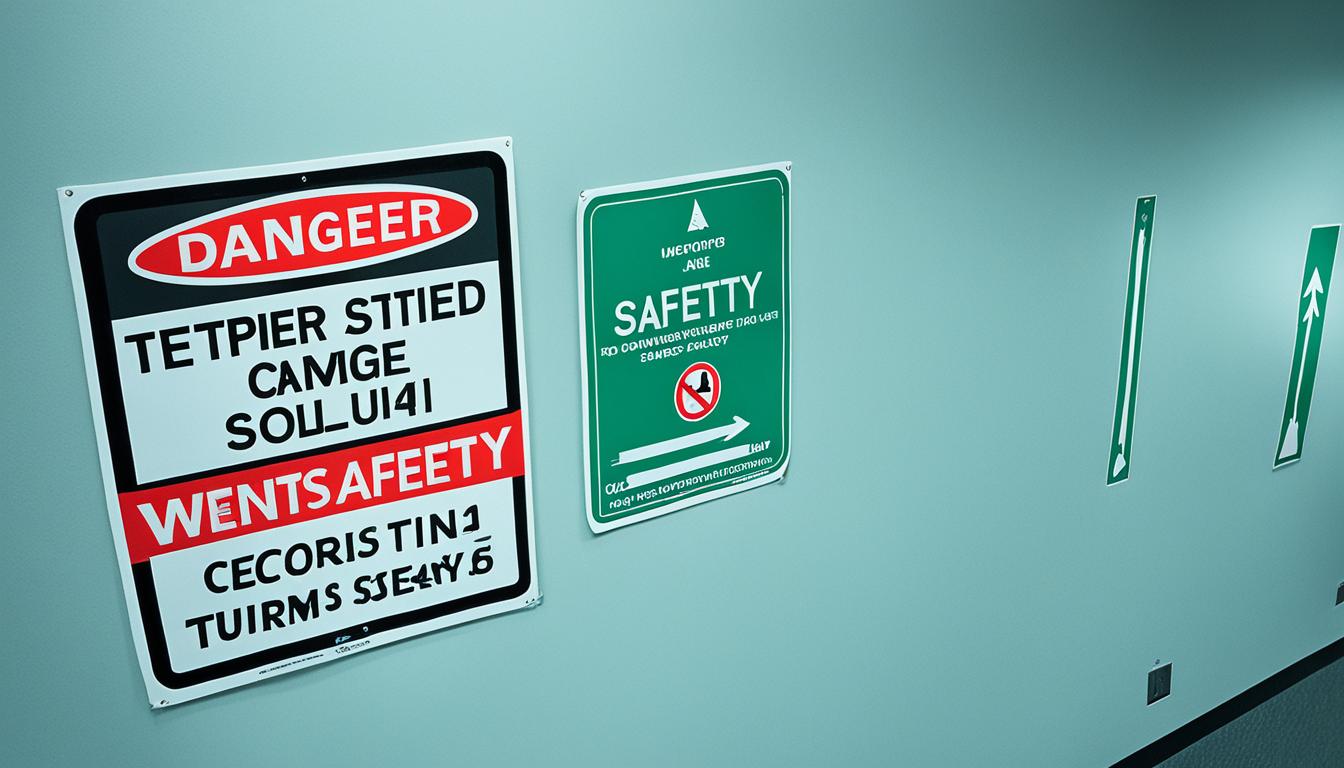A Guide to HR Employee Safety Protocols
Welcome to our comprehensive guide on HR Employee Safety Protocols. In today’s rapidly evolving workplace, ensuring the safety and well-being of employees has become a top priority for organizations. HR Employee Safety Protocols encompass a wide range of guidelines and procedures designed to promote workplace safety and comply with Occupational Health and Safety (OHS) policies. These protocols cover various aspects of safety and security, including workplace safety measures and workplace security measures.
Key Takeaways
- HR Employee Safety Protocols aim to ensure workplace safety and compliance with OHS policies.
- Workplace safety measures encompass policies, procedures, and hazard control techniques.
- Workplace security measures focus on protecting employees from internal and external security risks.
- The primary federal law governing workplace safety is the OSH Act, enforced by OSHA.
- HR plays a vital role in developing safety programs and fostering open communication.
Workplace Safety Measures
Workplace safety is of paramount importance for organizations to protect their employees and create a secure working environment. Implementing comprehensive workplace safety protocols and employee safety guidelines is crucial to minimize accidents and injuries. Here are some essential safety measures that organizations should consider:
- Policies and Procedures: Establish clear and concise safety policies and procedures that address potential hazards specific to the workplace. These guidelines should be easily accessible to all employees.
- Hazard Control Techniques: Safety professionals follow a hierarchy of measures to eliminate or control workplace hazards. These techniques include substitution, isolation, ventilation, administrative controls, and personal protective equipment (PPE).
- Organizational Culture: Foster a supportive organizational culture that prioritizes workplace safety. This includes promoting accountability, open communication, and proactive safety practices.
- Goals and Objectives: Set clear goals and objectives related to workplace safety to guide employees and measure program success. Regularly assess and update these goals to ensure continuous improvement.
- Measurement Systems: Implement measurement systems to track the effectiveness of workplace safety programs. Regularly analyze safety data, conduct safety inspections, and review incident reports to identify areas for improvement.
Quote:
“Safety isn’t expensive, it’s priceless.” – Unknown
Employers must invest in employee safety and take proactive steps to prevent workplace accidents. By implementing robust workplace safety measures, organizations can create a secure environment that safeguards their most valuable asset – their employees.
Sample Table:
| Safety Measure | Description |
|---|---|
| Regular Safety Training | Ensure all employees receive comprehensive safety training to understand potential hazards and safety procedures. |
| Emergency Response Plan | Develop an emergency response plan that outlines procedures for evacuations, medical emergencies, and other crisis situations. |
| Personal Protective Equipment (PPE) | Provide employees with appropriate PPE, such as helmets, safety goggles, gloves, and masks, to protect against workplace hazards. |
| Regular Equipment Maintenance | Establish a maintenance schedule for equipment and machinery to ensure they are in optimal working condition and pose no safety risks. |
| Safe Lifting Procedures | Train employees on proper lifting techniques to prevent musculoskeletal injuries due to heavy lifting. |
Workplace Security Measures
In any organization, the safety and security of employees should be a top priority. Workplace security measures are designed to protect employees from both internal and external security risks. Implementing robust security protocols and procedures is essential for maintaining a safe work environment. These measures ensure that employees can carry out their responsibilities without unnecessary risks or threats.
Workplace security encompasses a wide range of practices and protocols that address various security risks. Here are some key measures that organizations should consider:
- Establishing a formal security function: Designate a dedicated team or individual responsible for overseeing security-related matters within the organization. This helps ensure that all aspects of security are properly managed and monitored.
- Implementing computer and internet policies: Develop clear policies regarding the use of computers and the internet in the workplace. These policies should address issues such as data security, acceptable use of company resources, and protection against cyber threats.
- Developing crisis management and contingency plans: Prepare comprehensive plans to handle potential crises and emergencies that may arise in the workplace. These plans should include procedures for evacuation, communication, and recovery to minimize the impact of any unforeseen events.
- Installing premises security systems: Utilize security systems such as access control systems, surveillance cameras, and alarm systems to monitor and secure the workplace. These systems act as deterrents and help detect and respond to security breaches effectively.
- Addressing restricted access policies: Implement policies and procedures to restrict access to sensitive areas of the workplace. Limiting access helps prevent unauthorized individuals from entering restricted areas and reduces the risk of internal security threats.
- Implementing key-control procedures: Establish protocols for the management and control of keys and access cards within the organization. Proper key control helps ensure that only authorized personnel have access to specific areas, minimizing the risk of unauthorized entry.
- Theft and fraud prevention procedures: Develop procedures and protocols aimed at preventing theft and fraudulent activities within the workplace. This may include inventory control, asset tracking, and implementing reporting mechanisms to address any suspicious activities.
By implementing these workplace security measures, organizations can create a secure environment that prioritizes employee safety and minimizes security risks. These measures contribute to the overall well-being of employees and demonstrate a commitment to their safety.
Additional Resources:
If you’d like to delve deeper into workplace security, here are a few additional resources that may be of interest:
1. “Workplace Security Best Practices” – A comprehensive guide by the National Crime Prevention Council that outlines best practices for workplace security and provides actionable strategies to enhance safety.
2. “OSHA Workplace Violence Prevention” – A resource from the Occupational Safety and Health Administration (OSHA) that provides guidance on preventing workplace violence and addressing security concerns.
3. “Security Management Magazine” – A publication that covers the latest trends, best practices, and case studies in the field of security management, offering valuable insights for organizations looking to enhance their security measures.
| Workplace Security Measures | Key Considerations |
|---|---|
| Establishing a formal security function | An effective security function ensures centralized management and oversight of security matters throughout the organization. |
| Implementing computer and internet policies | Clear policies help mitigate the risk of data breaches, cyber threats, and misuse of company resources. |
| Developing crisis management and contingency plans | Well-prepared plans enable organizations to effectively respond to emergencies and minimize disruptions. |
| Installing premises security systems | Physical security systems act as a deterrent and ensure prompt detection and response to security incidents. |
| Addressing restricted access policies | Limiting access to critical areas reduces the risk of unauthorized entry and internal security threats. |
| Implementing key-control procedures | Proper key control ensures authorized personnel have access to specific areas, enhancing overall security. |
| Theft and fraud prevention procedures | Effective procedures mitigate the risk of theft and fraudulent activities within the organization. |
Legal Framework for HR Employee Safety
The Occupational Safety and Health Act of 1970 (OSH Act) is the primary federal law that governs workplace safety in the United States. This act establishes legal requirements for workplace safety and places the responsibility for maintaining a safe and healthy work environment on employers. Under the OSH Act, employers are required to comply with safety and health standards enforced by the Occupational Safety and Health Administration (OSHA).
One of the key legal requirements imposed by the OSH Act is the obligation for employers to keep their workplaces free from recognized hazards. This means that employers must take steps to identify and eliminate or control any potential hazards that could pose a risk to the safety or health of their employees. It is essential for employers to conduct regular inspections and risk assessments to identify potential hazards and implement appropriate control measures.
The OSH Act also mandates employers to provide safety and health training to their workers. This training ensures that employees are equipped with the necessary knowledge and skills to perform their jobs safely and to respond effectively to any workplace hazards or emergencies that may arise. By providing comprehensive training programs, employers can empower their employees to actively participate in maintaining a safe work environment.
Additionally, workplace security measures are subject to constitutional and common law protections, as well as federal and state statutes. These laws address various aspects of workplace security, including workplace monitoring, surveillance, and searches. It is crucial for employers to understand and comply with these laws to protect the privacy and rights of their employees while also ensuring a secure working environment.
“Employers must comply with safety and health standards enforced by OSHA and keep their workplaces free of recognized hazards.”
Maintaining Compliance with Workplace Safety Laws
Complying with the legal requirements for workplace safety is not only essential for fulfilling the obligations imposed by the OSH Act, but it is also crucial for protecting the well-being of employees and minimizing the risk of accidents, injuries, and legal liability for employers.
To ensure compliance with workplace safety laws, employers should:
- Regularly review and update their safety policies and procedures to align with the latest standards and regulations.
- Provide ongoing safety training and education to employees to promote awareness and understanding of workplace hazards and safe work practices.
- Establish clear reporting mechanisms and procedures for employees to report safety concerns or incidents.
- Conduct regular inspections and risk assessments to identify potential hazards and implement appropriate control measures.
- Keep detailed records of safety training, inspections, and incident reports to demonstrate compliance with workplace safety laws.
| Key Steps for Ensuring Workplace Safety Compliance | Benefits |
|---|---|
| Regularly review and update safety policies and procedures | Ensure alignment with current standards and regulations |
| Provide ongoing safety training and education | Promote awareness and understanding of workplace hazards and safe practices |
| Establish clear reporting mechanisms and procedures | Prompt identification and resolution of safety concerns |
| Conduct regular inspections and risk assessments | Identification and mitigation of potential hazards |
| Keep detailed records of safety activities | Evidence of compliance and readiness to address issues |
By prioritizing workplace safety and adhering to the legal framework set forth by the OSH Act and other applicable laws, employers can create a safer and healthier work environment for their employees while mitigating the risk of accidents, injuries, and legal consequences.
HR Role in Workplace Safety and Security
HR professionals play a crucial role in ensuring the safety and security of the workplace. They are responsible for developing comprehensive safety programs, ensuring compliance with the Occupational Safety and Health Act (OSH Act), and implementing policies to protect trade secrets and prevent workplace violence. Effective communication about safety goals, policies, and practices is essential to foster a culture of safety. HR should establish a safety task force comprising employees who can provide valuable input and help review manuals, policies, and procedures.
Safety Program Development
An effective safety program is vital for minimizing accidents and injuries in the workplace. HR professionals are at the forefront of developing these programs, which involve identifying and assessing potential hazards, implementing control measures, conducting regular safety training, and monitoring compliance. By actively engaging in safety program development, HR can help create a culture of safety where employees understand the importance of following safety protocols and procedures.
Safety Communication
Clear and open communication about safety is crucial for promoting a safe work environment. HR plays a pivotal role in communicating safety goals, policies, and practices to employees. This includes conducting safety orientations, organizing safety meetings, and disseminating information through various channels. HR should ensure that employees are aware of potential hazards, understand safety procedures, and have access to resources for reporting safety concerns.
Responsibilities of HR in Workplace Safety and Security
| Responsibility | Description |
|---|---|
| Safety Program Development | Developing comprehensive safety programs to identify and mitigate workplace hazards. |
| OSH Act Compliance | Ensuring compliance with the Occupational Safety and Health Act and related regulations. |
| Policy Creation | Creating and implementing policies and procedures to protect trade secrets and prevent workplace violence. |
| Safety Training | Conducting safety training sessions to educate employees about potential hazards and safety protocols. |
| Safety Communication | Facilitating clear and effective communication about safety goals, policies, and practices. |
Importance of Open Communication
Open communication plays a critical role in fostering a safe workplace environment. It is essential for employees to feel comfortable reporting issues and sharing safety concerns without the fear of reproach. When employees trust their HR department and feel confident in openly communicating with them, it helps to create an atmosphere that prioritizes employee well-being and supports a culture of safety.
To foster open dialogues, HR departments can adopt various strategies:
- Consistent One-on-One Meetings: HR managers should regularly schedule individual meetings with employees to discuss any safety concerns, address questions, and provide guidance. These personalized interactions help build trust and create a supportive atmosphere.
- Creating Inviting Spaces: Designate areas within the workplace that are conducive to relaxation and engagement. These spaces can facilitate informal conversations, making it easier for employees to approach HR with any safety-related issues they may have.
- Addressing Concerns Immediately: HR should prioritize prompt responses to safety concerns raised by employees. By promptly addressing and resolving these concerns, HR demonstrates a commitment to employee safety and cultivates trust in the department’s ability to maintain a secure work environment.
When open communication is prioritized in the workplace, employees are more likely to report potential safety hazards and seek assistance. This proactive approach helps mitigate risks and empowers HR to take appropriate actions promptly. Consequently, trust between employees and the HR department strengthens, contributing to a safer work environment overall.
| Benefits of Open Communication for Workplace Safety | Actions for fostering open communication |
|---|---|
| 1. Increased employee engagement and satisfaction | – Regular one-on-one meetings – Encouraging feedback and suggestions |
| 2. Early identification and resolution of safety concerns | – Creating inviting spaces for dialogue – Promptly addressing concerns |
| 3. Improved safety culture and awareness | – Training programs on safety protocols – Open door policy for safety discussions |
| 4. Enhanced trust in HR department | – Active listening and empathy – Transparency in decision-making |
“Open communication is the cornerstone of a strong safety culture. When employees feel comfortable expressing their concerns and ideas, it empowers HR departments to proactively address safety issues and foster an environment that puts employee well-being first.”
Stress Reduction for Employee Safety
Job-related stress can have detrimental effects on employee safety, contributing to workplace accidents and injuries. In order to prioritize the well-being of employees and ensure a safe working environment, it is crucial for employers to proactively address and reduce job-related stress. By implementing strategies to reduce stress levels, employers can improve the overall workplace atmosphere and enhance safety measures.
Employers should start by assessing the existing needs and identifying the key sources of job-related stress within the organization. This can be achieved through employee surveys, focus groups, or confidential feedback channels. By gaining insight into the specific stressors, employers can tailor their efforts towards creating targeted solutions.
Improving the Corporate Culture
One effective way to reduce job-related stress is by improving the corporate culture of the organization. A positive work environment that fosters support, collaboration, and open communication can alleviate stress and promote employee well-being. Employers should encourage teamwork, provide opportunities for professional growth and development, and recognize and reward achievements.
Creating an Acknowledging and Supportive Atmosphere
In addition to improving the corporate culture, employers should create an atmosphere where employees feel acknowledged and supported. This can be achieved through various initiatives, such as:
- Regularly acknowledging employees’ efforts and accomplishments through verbal recognition or written acknowledgments
- Providing resources and support for employees to manage their workload effectively
- Offering employee assistance programs or access to mental health professionals
- Encouraging work-life balance and promoting a healthy lifestyle
By addressing job-related stress and promoting a positive work environment, employers stand to gain multiple benefits. Not only does reducing stress contribute to improved employee well-being, but it also leads to increased productivity, decreased absences, and enhanced overall safety in the workplace.
“Creating a supportive work environment is key to reducing job-related stress and ensuring employee safety. By acknowledging and addressing stressors, employers can foster a positive workplace atmosphere that promotes well-being and enhances overall safety measures.”
| Effects of Stress Reduction on Employee Safety | Benefits |
|---|---|
| Improved focus and concentration | Reduced likelihood of accidents and injuries caused by distractions |
| Enhanced decision-making abilities | Better judgement and quick response to potential hazards |
| Reduced physical and mental fatigue | Lower risk of errors due to exhaustion |
| Increased job satisfaction | Higher employee morale and motivation to comply with safety protocols |
Safety Incentives for Employee Safety
Safety incentives are a powerful tool to increase employee awareness of workplace safety and demonstrate management’s commitment to their well-being. By implementing incentive programs, organizations can promote employee engagement in proactive safety behaviors and foster a culture of safety consciousness.
These programs should be tailored to the specific needs and preferences of employees, ensuring they align with the organization’s safety goals. They should focus on rewarding positive behaviors that contribute to a safer work environment, such as attending safety meetings and reporting hazards promptly.
Clear guidelines for performance measurement, monitoring, and reward systems are critical for the success of these programs. Performance should be assessed based on predetermined safety metrics, allowing employees to track their progress and providing motivation for continued adherence to safety protocols.
Benefits of Safety Incentive Programs
- Increased employee engagement in safety practices
- Improved safety awareness and hazard reporting
- Encouragement of proactive behaviors
- Recognition for safety achievements
- Enhanced safety culture within the organization
Implementing safety incentives not only reduces the number of injuries and accidents but also reinforces positive safety behaviors among employees. When employees feel recognized and rewarded for their commitment to safety, they are more likely to actively participate in maintaining a safe work environment.
“Safety incentive programs provide tangible rewards for employees, promoting a proactive mindset towards safety and creating a positive workplace culture.”
By incorporating safety incentives into the overall safety program, employers can achieve the ultimate goal of preventing accidents and ensuring the well-being of their workforce.
Sample Safety Incentive Program
Here’s an example of a safety incentive program that can effectively promote proactive behaviors:
| Positive Behavior | Reward |
|---|---|
| Attendance at safety meetings | Gift cards or additional paid time off |
| Timely reporting of hazards | Recognition certificates or monetary bonuses |
| Consistent adherence to safety protocols | Preferred parking spots or team outings |
By offering attractive rewards that align with the preferences of employees, organizations can motivate individuals to actively engage in safety practices and create a safer work environment for everyone.
Conclusion
HR Employee Safety Protocols are instrumental in maintaining workplace safety and adhering to Occupational Health and Safety (OHS) policies. By implementing comprehensive safety measures, fostering open communication, reducing job-related stress, and offering safety incentives, employers can create a secure work environment that prioritizes employee well-being and mitigates unnecessary costs. It is important to recognize that workplace safety is not just a legal requirement, but also a strategic investment that contributes to the overall success and productivity of the organization.
Through the implementation of workplace safety protocols, employers demonstrate their commitment to ensuring the physical and mental health of their workforce. By adhering to HR Employee Safety Protocols, businesses can create a culture of safety that promotes a positive work environment. Open communication channels empower employees to report safety concerns without fear of retribution, fostering a proactive approach to addressing potential hazards.
Additionally, the reduction of job-related stress plays a crucial role in employee safety. Employers should strive to create an atmosphere that supports their employees’ well-being, acknowledging their efforts and providing necessary resources. By recognizing and addressing the impact of stress on workplace safety, organizations can enhance productivity, decrease absenteeism, and establish a culture of care and respect.
Safety incentives serve as a powerful tool for encouraging and reinforcing positive safety practices. Through rewards and recognition, employers can motivate employees to actively engage in safety protocols, attend safety meetings, and report potential hazards. Such incentives help promote a proactive safety culture, resulting in a reduction of accidents and injuries, and ultimately leading to a safer work environment for all.







